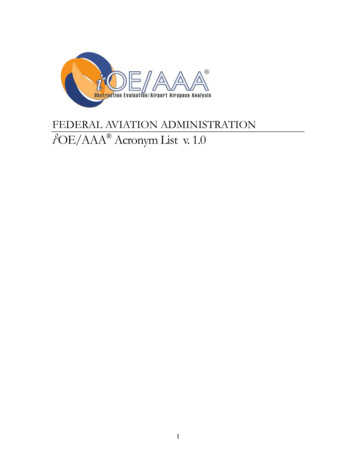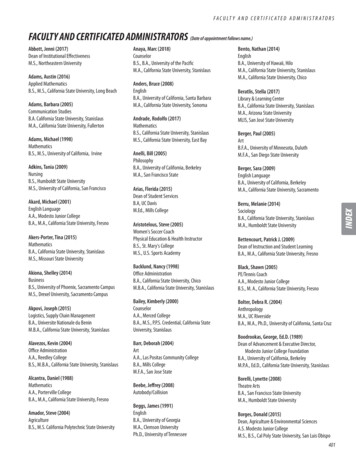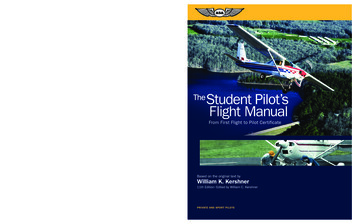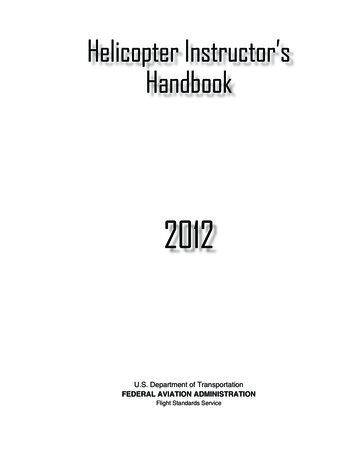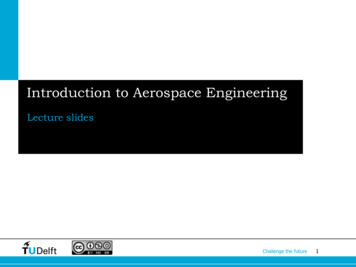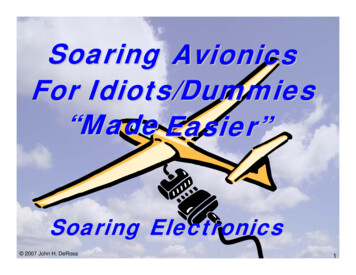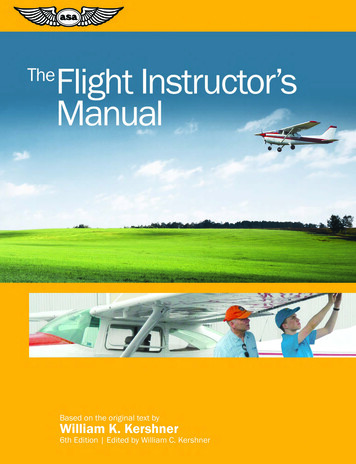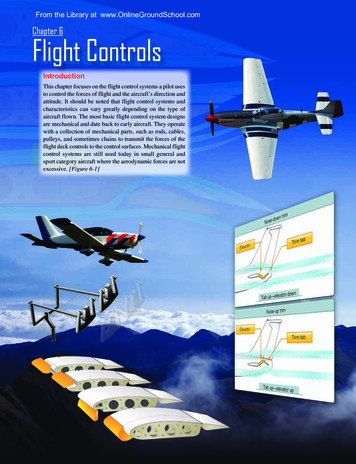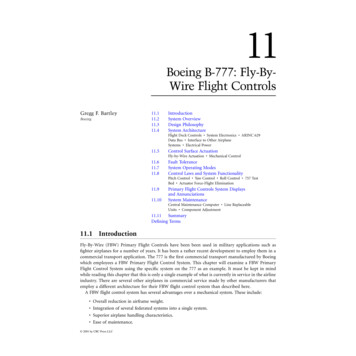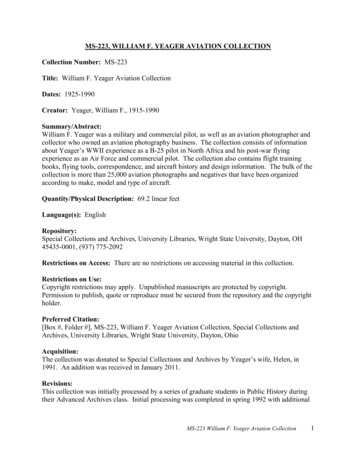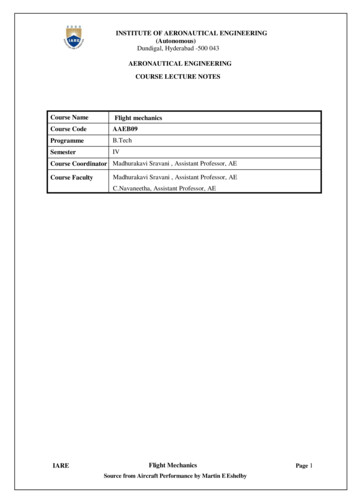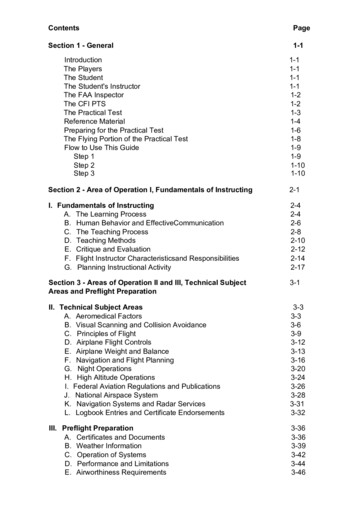
Transcription
ContentsPageSection 1 - General1-1IntroductionThe PlayersThe StudentThe Student's InstructorThe FAA InspectorThe CFI PTSThe Practical TestReference MaterialPreparing for the Practical TestThe Flying Portion of the Practical TestFlow to Use This GuideStep 1Step 2Step on 2 - Area of Operation I, Fundamentals of Instructing2-1I. Fundamentals of InstructingA. The Learning ProcessB. Human Behavior and EffectiveCommunicationC. The Teaching ProcessD. Teaching MethodsE. Critique and EvaluationF. Flight Instructor Characteristicsand ResponsibilitiesG. Planning Instructional Activity2-42-42-62-82-102-122-142-17Section 3 - Areas of Operation II and III, Technical SubjectAreas and Preflight Preparation3-1II. Technical Subject AreasA. Aeromedical FactorsB. Visual Scanning and Collision AvoidanceC. Principles of FlightD. Airplane Flight ControlsE. Airplane Weight and BalanceF. Navigation and Flight PlanningG. Night OperationsH. High Altitude OperationsI. Federal Aviation Regulations and PublicationsJ. National Airspace SystemK. Navigation Systems and Radar ServicesL. Logbook Entries and Certificate 283-313-32III. Preflight PreparationA. Certificates and DocumentsB. Weather InformationC. Operation of SystemsD. Performance and LimitationsE. Airworthiness Requirements3-363-363-393-423-443-46
ContentsPageSection 4 - Area of Operation IV, Preflight Lesson on a Maneuver 4-1to be Performed in FlightIV. Preflight Lesson on a Maneuver to be Performed in Flight 4-1A. Sample WhiteboardA. Sample Lesson Plan4-24-3Section 5 - Areas of Operation V through XIII, Maneuvers5-1V. Preflight ProceduresA. Preflight InspectionB. Single-Pilot Crew Resource ManagementC. Engine StartingD. Taxiing - LandplaneG. Before Takeoff Check5-45-45-75-95-125-15VI. Airport OperationsA. Radio Communications and ATC Light SignalsB. Traffic PatternsC. Airport, Runway and Taxiway Signs, Markings, and Lighting 5-265-195-195-21VII. Takeoffs, Landings, and Go-AroundsA. Normal and Crosswind Takeoff and ClimbB. Short-Field Takeoff and Maximum Performance ClimbC. Soft-Field Takeoff and ClimbF. Normal and Crosswind Approach and LandingG. Slip to a LandingH. Go-Around/Rejected LandingI. Short-Field Approach and LandingJ. Soft-Field Approach and LandingK. Power-Off 180 Accuracy Approachand I. Fundamentals of FlightA. Straight-and-Level FlightB. Level TurnsC. Straight Climbs and Climbing TurnsD. Straight Descents and Descending Turns5-635-695-715-745-77IX. Performance ManeuversA. Steep TurnsB. Steep SpiralsC. ChandellesD. Lazy Eights5-805-805-835-865-88X. Ground Reference ManeuversA. Rectangular CourseB. S-Turns Across a RoadC. Turns Arounda PointD. Eights on Pylons5-905-925-955-985-102
ContentsPageXI. Slow Flight, Stalls, and SpinsA. Maneuvering During Slow FlightB. Power-On StallsC. Power-Off StallsD. Crossed-Control StallsE. Elevator Trim StallsF. Secondary StallsG. SpinsH. Accelerated Maneuver 8XII. Basic Instrument ManeuversA. Straight-and-Level FlightB. Constant Airspeed ClimbsC. Constant Airspeed DescentsD. Turns to HeadingsE. Recovery from Unusual Flight Attitudes5-1305-1345-1365-1395-1415-143XIII. Emergency OperationsA. Emergency Approach and LandingB. Systems and Equipment MalfunctionsC. Emergency Equipment and Survival GearD. Emergency Descent5-1455-1465-1505-1525-153XIV. Postflight ProceduresA. Postflight Procedures5-1555-155Appendix 1. An Example of the First Three Pages, the Task,Strategy, and Reference Materials ListA 1-1Appendix 2. Reference Documents for Fundamentals of Instructing A 2-1Appendix 3. Reference Material - Logbook Entries and Certificate A-3-1EndorsementsAppendix 4. Mini Lessons/Special TopicsA 4-1Appendix 5. Flight Check TimetableA 5-1Appendix 6. Tracking Checklist16-1
Section 1GeneralIntroductionThis guide has been designed to assist anyone involved in Flight Instructortraining. It can be used by a perspective applicant preparing for the FlightInstructor certificate. It can be used by the Flight Instructor preparing aprospective Flight Instructor. It is my hope it will be used by FAA Inspectorstesting a Flight Instructor applicant.The idea for this guide has been floating around in my head for some time. Afterretiring from the FAA, with just short of 30 years as an Operations Inspector, Idecided to teach part-time. My agreement with the owner of the school where Iteach is that I could focus my efforts on Flight Instructor students. Between myexperience as an Inspector, giving Initial Flight Instructor flight checks andworking with students, it became increasingly obvious that there just wasn't anyreal hands-on guidance designed to prepare the Flight Instructor student.The more I work with students, the more I find a disconnect between the task ofpreparing a would-be flight instructor and what the Certificated Flight Instructor(CFI) Practical Test Standards (PTS) is all about.Writing this guide also became important to me on a more personal basis, as Irealized how far too many of my fellow FAA Inspectors failed to understand theintent of the PTS and how their application of it was inconsistent. In retrospect,that statement is probably an analysis of my own Flight Instructor checkrides asan Inspector.Part of preparing a Flight Instructor Student includes making sure that theyunderstand what takes place, who the folks are that they will meet and work with,what they do and do not need to learn, and where they fit into the puzzle. I havealso tried to explain how the PTS works and what to expect in the Practical Test.The PlayersPreparing a would-be Flight Instructor is like a three-legged stool. There is astudent, there is the student's instructor and there is the Inspector. If any of thelegs isn't holding up its part of the stool, the stool tips over.The Student (aka, the CFI Student, the CFI applicant, the applicant)Let’s start with the central figure, the student seeking a Flight Instructorcertificate. He is usually under 25 and has around 250 hours total flight time. Hisgoal isn't usually to become a career Flight Instructor, it's to gain hours andexperience to move up in the aviation world. Up until the day the student startstraining to become a Certificated Flight Instructor; he has only been a studentlearning to fly. With 250 hours a student is like a sponge, with a very limitedbase of experience but eager to learn. In the role of a "student" he has typicallybeen a receiver of information, far too often taking what he is taught as gospel.This is not a criticism; it is an observation. Once he becomes a Flight Instructor,the roles change; he becomes a dispenser of information and a recipient of"Why?" questions.The Student's InstructorTo begin with, this guy has to have 200 hours as an Instructor and has to havebeen a CFI for at least two years. That makes him a really old guy. Beyond hisage and experience he is hard to describe. In my case I am retired, wanting to1-1
give back something to flying. The fellow I work with is the owner of a flightschool and a Designated Pilot Examiner. He is over 60. Most everyone thatteaches Flight Instructor students has been around for a while. That experienceis what is necessary to help the student learn how to answer the "Why?"question.The FAA InspectorThe FAA Inspector is usually seen as the bad guy, the obstruction, agd the gatethrough which all CFI applicants have to pass on their way to their goal.In fact FAA Inspectors are human beings and put their pants on one leg at atime, just like everyone else. With very few exceptions, FAA Inspectors do notget a thrill when they fail CFI applicants. In reality they are just as frustrated asanyone when they get an ill-prepared applicant, and they get far too many ofthem.FAA Inspectors receive little or no formal training regarding the use of the FlightInstructor PTS. That does not diminish their basic skills; it means they are doingthe best they can with what they have. It also means they interpret the PTS fromtheir own individual perspective. This is what contributes to inconsistency.FAA Inspectors are generally over-worked and spread too thin. A GeneralAviation Operations Inspector must have a working knowledge of about twodozen regulations, a new Handbook that has been described as over a foot thick,as well as tons of other guidance material. They are also responsible forhundreds of skill sets including accident investigation, legal enforcement,airline/operator certification, Designated Pilot Examiner oversight, airshowsurveillance, 709 re-examinations, and medical flight checks, among others.Flight Instructor certification is but a small part of an inspector's workweek.The CFI PTSThe CFI PTS is the bible when it comes to CFI training and testing. Reading andunderstanding it should be the first thing anyone wanting to get their CFI shoulddo. It should be in the student's hands whenever receiving training or practicingteaching.The CFI PTS as published by the U.S. Department of Transportation, FederalAviation, Airman Testing Standards Branch, AFS-630 is divided into three majorparts: The first part is the Introduction, which is general in nature and explains howto use the PTS. (Everything from the Cover Page through the ContentsPages) The second part is titled, SECTION 1, FLIGHT INSTRUCTOR AIRPLANESINGLE-ENGINE, Practical Test Standards. It describes all of the Areas ofOperations, Tasks and Elements for Airplanes with one engine. The third part is titled, SECTION 2, FLIGHT INSTRUCTOR AIRPLANEMULTIENGINE, Practical Test Standards. It describes all of the Areas ofOperations, Tasks and Elements for Airplanes with two or more engines.SECTION 1 defines how single-engine practical tests are to be conducted. Itestablishes the Areas of Operation and Tasks. It also describes the Elementswithin the Tasks, and it establishes the standards of performance. It also has alist of all of the references used in its development and administration.For our purposes we will only be concerned with the first two parts of the CFIPTS.1-2
The PTS is the one document that the Student, the Student's Instructor and theFAA Inspector must follow when conducting the Practical Test.Another function of the PTS is to define the regulatory nature of the FlightInstructor Practical Test. The only "standards" of acceptable performance arethose listed in the PTS. The success or failure of any given task must be judgedsolely by the standards of the particular Task.The Practical TestCertificated Flight Instructor applicants have a horrible failure record. Actually,their failure rate is remarkable; it's their pass record that is horrible. Mostapplicants fail the "oral" portion of the test. "Oral" is code for that portion of thePractical Test that happens before the flying part of the test. There really isn't an"oral" or a "flight" any longer. It is all rolled up into a Practical Test and the "oral"isn't really over until the Inspector signs the certificate.Far too many Instructors, who prepare CFI applicants, believe that the focus ofthis test is the applicant's flying ability. In fact, the focus should be the ability tocommunicate ideas, organize thoughts and therefore teach. Flying is importantbut less often the cause of a failure. Keep in mind, the applicant has alreadyshown his prowess as a pilot when he took his Private, Commercial andInstrument Rating flight checks.The PTS is set up in a very logical fashion. It starts with the Fundamentals ofInstruction, moves to Technical Subjects, and then Preflight Preparation. At thispoint there is a shift to teaching a flight maneuver from a lesson plan, which willbe taught in-flight. Once that is completed the applicant and Inspector aregenerally off to the airplane to fly. The flight covers a generous sampling of thePrivate and Commercial maneuvers as well as the maneuver that was thesubject of the lesson plan.Once the flight portion of the Practical Test is completed satisfactorily, theInspector issues the applicant a certificate.Back to what happens during the "oral.” Even the best flight instructors do nothave all of the knowledge in the world when it comes to aviation. The really goodones rely on a solid basis of personal information, which they supplement withlots of reference materials. Some of this is store bought, some is collected fromreliable sources and some is home made. This should be true of someonepreparing to become a CFI. They start with their own base of knowledge andadd to it as they learn. They develop a reference library. They use that library tolearn how and what to teach. They use that library while they are FlightInstructing, and they should use that library while taking the Practical Test.That's why the CFI PTS says: "The term 'instructional knowledge’ means theinstructor applicant is capable of using the appropriate reference to provide the'application or correlative level of knowledge' of a subject matter topic, procedure,or maneuver."What an applicant is not allowed to do is to look up every answer. For thepurpose of this guide, there are two types of reference materials. The first is thelist of references used as the basis for the CFI Practical test. This list is found inthe Introduction of the CFI PTS. It is supplemented by Task specific referencelists in each task. The second type of reference material used is the onedeveloped by and for the Instructor. When preparing a reference library, itshould be assembled using the reference list in the PTS and from personallydeveloped/collected reference document(s). More about this process will befound further along in this guide.1-3
Tho practical test for the CFI should not be a series of questions asked by theInspector and answered by the applicant. That is how Private and CommercialPractical Tests are conducted. Almost every Objective in the CFI PTS haslanguage that says something like: "exhibits instructional knowledge of theelements of.by describing:" That concept is a significant departure from thePrivate or Commercial practical test where the PTS says: "To determine that theapplicant exhibits knowledge of. by explaining."The CFI practical test isn’t about memorizing anything. That's for the written test.It's about knowing the material to be taught and understanding the conceptsbehind that material. If a student knows "TOMATO FLAMES" but does notunderstand that it may not answer the whole question: "Does this airplane haveall of the equipment required for this flight?" then he does not understand thesubject of required equipment. Likewise, if an Instructor believes that ARROWstands for the paperwork that must be onboard the airplane in order to fly, I issuea challenge: find a regulatory reference that says that. Again the "oral" is aboutteaching and not about minutia.Because of the language in the Flight Instructor PTS, it's my opinion that the"oral" should go something like this. The Inspector says: "I have selected Task Jof Area of Operation II for you to teach. I am a student pilot with 14 hours. Ihave soloed at an uncontrolled airport and am about to take my first dual cross country. I will be going to an airport with a control tower and along the way I willbe transitioning through Class C airspace. Using the Elements of that Taskteach me about the National Airspace System." The CFI applicant then puts histhoughts together, digs out a teaching aid and teaches the information requiredby the Task. As the lesson progresses, the Inspector would then ask questions,but only the kind that a student, at the prescribed level, would ask if theinformation presented didn't make sense or wasn't clear. The Inspector wouldalso reserve the right to ask additional subject matter questions, if he didn't thinkthe material presented was accurate or that the applicant didn't have a commandof the subject matter. The latter type of questions would tend to be more direct innature, aimed at determining if the applicant knows the basic information."Orals" do not always go like that, but one can hope.This approach would allow the applicant to teach the material in a logical andrealistic manner.Reference MaterialThe FAA uses the PTS to define the material the applicant must study and knowin order to successfully pass a practical test. I like to use the term "sandbox" todescribe the concept. Think of a group of kids playing in a sandbox. They areexpected to follow a set of rules: don't throw the sand, don't eat the sand, andkeep the sand in the box. Everyone playing has to know the rules and isexpected to follow them. So it is with the list of references in the FAA sandbox.The student has to learn and demonstrate "instructional knowledge" of theinformation in those references. The Student's Instructor has to teach from thosereferences, and the FAA Inspector has to test from those references. Only thestudent or the student's Instructor has the right to expand that list. If the studentdoesn’t venture outside the list of FAA references, the Inspector can't either. Thereference material listed in the PTS is what anyone seeking their CFI shouldstudy, know and know how to work with. Be careful with using material fromoutside the sandbox. It may not be accurate. It may be too complicated. It maylead to more questions than it answers, and an applicant may find that one1-4
Inspector who knows the information better than anyone else and turns theapplicant inside out and backwards with questions. The best example of this isthe book Aerodynamics for Naval Aviators. It’s a great book, but it isn’t on thelist. If a student elects to use it and refers to it, then the FAA Inspector can askquestions about it. If the student isn't sure or gets lost or confused, the chancesof passing go down.There is no reason to be an aeronautical engineer or a rocket scientist. I have abrother-in-law that fills both descriptions. He is a great source of information. Iask him to explain lots of things to me, but only after I send him the text from oneof the FAA publications on the following list.These practical test standards are based on the following references: . 14 CFR part 1 Definitions and Abbreviations14 CFR part 23 Airworthiness Standards: Normal, Utility, Acrobatic, andCommuter Category Airplanes14 CFR part 39 Airworthiness Directives14 CFR part 43 Maintenance, Preventative Maintenance, Rebuilding, andAlteration14 CFR part 61 Certification: Pilots and Flight Instructors14 CFR part 67 Medical Standards and Certification14 CFR part 91 General Operating and Flight RulesNTSB part 830 Notification and Reporting of Aircraft Accidents andIncidentsAC 00-6 Aviation WeatherAC 00-45 Aviation Weather ServicesAC 60-22 Aeronautical Decision MakingAC 60-28 English Language Skill Standards as Required by 14 CFR parts61,63, and 65AC 61-65 Certification: Pilots and Flight Instructors FAA-S-8081-6C 4AC 61-67 Stall and Spin Awareness TrainingAC 61-84 Role of Preflight PreparationAC 61-107 Operations of Aircraft at Altitude Above 25,000 feet MSL and/orMach Numbers (Mmo) Greater than 75AC 90-42 Traffic Advisory Practices at Airport Without Operating ControlTowersAC 90-48 Pilots' Role in Collision AvoidanceAC 90-66 Recommended Standard Traffic Patterns for AeronauticalOperations at Airports Without Operating Control TowersAC 91 -13 Cold Weather Operation of AircraftAC 91-55 Reduction of Electrical System Failures Following Aircraft EngineStartingAC 120-51 Crew Resource Management Training (Note 1)FAA-H-8083-1 Aircraft Weight and Balance HandbookFAA-H-8083-3A Airplane Flying HandbookFAA-H-8083-9A Aviation Instructor’s Handbook (Note 3)FAA-H-8083-27A Student Pilot Guide (Note 2)FAA-S-8081-4 Instrument Rating Practical Test StandardsFAA-S-8081-12B Commercial Pilot Practical Test StandardsFAA-S-8081-14A Private Pilot Practical Test StandardsFAA-H-8083-15A Instrument Flying Handbook1-5
FAA-H-8083-25A Pilot's Handbook of Aeronautical Knowledge (Note 3)Order 8080.6 Conduct of Airman Knowledge TestsAC 150/5340-1 Standards for Airport MarkingsAC 150/5340-18 Standards for Airport Sign SystemsAC 150/5340-30 Design and Installation Details for Airport Visual AidsAIM Aeronautical Information ManualA/FD Airport/Facility DirectoryNOTAMs Notices to AirmenPOH/AFM Pilot Operating Handbooks and FAA-Approved Airplane FlightManualsNavigation Charts (Note 1)(Note 1) (Reference found in FAA-S-8081-14A, Private Pilot Practical TestStandards and FAA-S-8081-12B, Commercial Pilot Practical Test Standards)(Note 2) References added by author. (The guy who wrote this guide.)(Note 3) In the summer of 2008 the FAA published two new referencedocuments, FAA-H-8083-9A Aviation Instructor’s Handbook and FAA-H-808325A Pilot's Handbook of Aeronautical Knowledge.Preparing for the Practical Test The "Oral" Portion of the Practical TestThe "oral” portion of the Practical Test usually takes place at the Flight StandardsDistrict Office (FSDO). That's because it is convenient for the Inspectors, andthey would like CFI applicants to have the experience of coming to the FlightStandards District Office. It is intimidating but not all that bad given theresponsibilities of a CFI. The applicant is generally signed-in at the front desk,after showing the prerequisite identification. Next the assigned Inspector showsup and leads the applicant to either his office or an area used for interviews andmeetings. After a short introduction, including location of facilities, the test starts.It isn't all that uncommon to get an introduction to the Practical Test that explainsthat this is just about the only flight test that the FAA mandates must be done byan FAA Inspector, and this is perhaps the most important rating of them all. Bothare important concepts to consider. If IACRA is being used the Inspector willhave the applicant electronically sign the application. At this point the applicantcan expect to be asked to "qualify himself." This translates to presentingidentification, an application, and a logbook. He will be asked to explain therequired endorsements and generally prove his eligibility for the test. In additionhe will be expected to present all of the aircraft documents and miscellaneousequipment required by the PTS. This is quite a departure from showing up forthe Private or Commercial Pilot Practical Test where the examiner looks throughthe material the applicant brings and proclaims "You look qualified, so let's startthe checkride."Once the applicant has explained how it is that he is eligible for the check ride,the Inspector starts with questions and scenarios. He will usually start with Areaof Operation I, Fundamentals of Instructing. He works his way through thePractical Test Standards one Area of Operation at a time. It is important that theapplicant follows along with his own copy of the PTS.At some point the applicant will be asked to teach the Inspector a flight maneuverthat will also be an in-flight lesson, Area of Operation IV. Generally when thatlesson is complete, assuming all has gone well, the applicant and the Inspectorwill be headed towards the airplane for the flying part of the checkride.1-6
Mandatory Areas of Operation and TasksLike Death and Taxes, THE APPLICANT WILL BE ASKED ABOUT Area ofOperation I, Task F. Flight Instructor Characteristics and Responsibilities andArea of Operations II. Task L. Logbook Entries and Certificate Endorsements.Given that inside tip, the applicant might as well become an expert on thosetopics. Even with that information, believe it or not, I failed more applicants onEndorsements than any subject other than airspace. If an applicant knowsendorsements, thoroughly, it should make proving that his logbookendorsements are correct a snap. I don't make this stuff up. The first sentenceof Area of Operation I. and II. tells the applicant what tasks are mandatory.That is true of flight maneuvers too. How to prepare for the "oral" on Fundamentals of Instructing (FOI)Look at the Renewal or Reinstatement of Flight Instructor Table in the PTS. Notethat Area of Operation I isn't included. The ONLY time an applicant will bequeried about Area of Operation I is during the initial CFI practical test. The restof the time applicants have to demonstrate the theory by applying it. Becausethis is about theory and the Inspectors conducting the Practical Tests are pilotsfirst and Instructors second, there is a good chance they will like Fundamentalsof Instruction just about as much as the applicant will. It isn't their favoritesubject.I believe the best way to really learn Fundamentals of Instruction is to learn bydoing and by finding examples of each term or concept. For example, there aretwo terms a CFI student will need to know as part of Fundamentals of Instruction,positive and negative transfer. The concept applies to much of how a FlightInstructor teaches a student, but there is no better example than the "touch andgo." I ALWAYS tell my CFI students that "I DO NOT DO TOUCH AND GOES,"and I don't. Then I ask if they do them, and if so, "Why?" I get lots of answers,but most center on the idea that they improve efficiency. "You can do moretakeoffs and landings if you do touch and goes." Once I have heard their logic, Itell them mine. When flying an airplane, especially a complex airplane, afterlanding, the pilot is expected to taxi clear of the runway, stop the airplane and gothrough the after-landing checklist. If a student of mine does anything other thanthat, I am very unhappy. If they insist, I will not keep them as a student. Thereason, I do not want my students doing "stuff” while they are supposed to bepaying attention to controlling the airplane. Most importantly, I do not want astudent grabbing the gear handle thinking it is the flap handle and retracting thegear. I simply have investigated far too many inadvertent gear retractions whilethe airplane was on the ground. Next, I ask, "How are habit patternsdeveloped?" and "How hard is it to break old ones?"Teaching a student to do touch and goes and then expecting them to not touchanything until they taxi off the runway is an example of negative transfer.Requesting "the option,” then landing, coming to a complete stop on the runway,and then cleaning up the airplane using the checklist, is an example of positivetransfer. It is not important that an applicant agrees with my theory about touchand goes; the point is to understand the terms and the theory involved inFundamentals of Instructing and then use those examples when describing them.By the way, is the touch and go a maneuver required by the PTS?NOTE: As indicated earlier, the FAA has published a new FAA-H-8083-9AAviation Instructor’s Handbook. Rather than comment on the value or the needfor the new handbook I want to point out a concern. As I stated earlier FAA1-7
Inspectors receive little or no formal training regarding the use of the FlightInstructor PTS. That statement is also true about the reference materials. Forthe most part, rewriting a handbook wouldn’t constitute a problem, except for theAviation Instructor’s Flandbook. Very few Inspector’s hold teaching credentials.Very few Inspectors have any formal training in the educational process. Thenew Instructor’s Flandbook includes a lot of new material, emphasizes newinformation and has been both enlarged and rearranged. Talk to your instructorabout the change and suggest that they discuss the matter with the local FSDO.My concern is that a CFI applicant will learn from the new Flandbook and betested from the old Flandbook. Flow to prepare for the "oral" on Technical SubjectsLet's move on to the technical subjects in Areas of Operation II. and III. Flavingthe technical subjects mastered is a great starting place, but the applicant will beonly halfway there. The next step is to be able to teach them. The best way toteach the material is to sit down with the PTS and carefully read each Task.Read each Task with a critical bent. Dissect it and if still confused ask aninstructor and of course look at my strategy for the particular Task. The point isan applicant should develop his own approach to teaching the material. The nextstep is to practice teaching. A CFI student should work with his Instructor to findsomeone to teach each Task to, over and over and over.The same idea goes for all of the "maneuvers," Areas of Operation V throughXIII. Read the Task and analyze the question, then develop an answer. Thenpractice teaching the maneuvers, first on the ground and then in the air.The "Flying" Portion of the Practical TestGetting to this part of the practical test assumes you have been successful atAreas of Operation I through IV. Now you are off to the airplane. If you willremember from my description of an FAA Inspector, I told you that they are likeeveryone else and put their pants on one leg at a time. If you believe they arehuman then you must believe they are fallible. If they are fallible then it goes thatyou must learn to insure the safety of each flight regardless of who is in the otherseat, even an FAA Inspector. That protection is both in terms of your personalsafety and the protection of your pilot and Flight Instructor certificates.Translated, you are Pilot-In-Command of the airplane you are flying, andtherefore you are in charge.One very good place to start is with a pilot briefing. If you fly with me you willhear something like this: "I am pilot-in-command; therefore I am responsible forthe airplane and the flight. If something goes wrong the FAA will look to me foranswers. If we experience an emergency, I get to make the final decision. Thatdoesn't mean I will take the controls away from you. In fact if you are at thecontrols when all hell breaks loose, I would expect you to keep flying and start todeal with the emergency. As the emergency progresses, I might elect to takeover and fly the airplane, maybe not; i
The Practical Test 1-3 Reference Material 1-4 Preparing for the Practical Test 1-6 The Flying Portion of the Practical Test 1-8 Flow to Use This Guide 1-9 Step 1 1-9 . school and a Designated Pilot Examiner. He is over 60. Most everyone that teaches Flight Instruc
